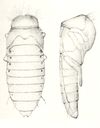Creophilus
Creophilus
Classification
- Phylum: Arthropoda
- Subphylum: Hexapoda
- Class: Insecta
- Order: Coleoptera
- Suborder: Polyphaga
- Superfamily: Staphylinoidea
- Family: Staphylinidae
- Subfamily: Staphylininae
- Tribe: Staphylinini
- Subtribe: Staphylinina
- Genus: Creophilus
Pronunciation
How to pronounce Creophilus: //kriˈɒfɪləs//
These audio files are automatically generated. While they are not always 100% accurate, they are a good starting point.
Images






Summary
Creophilus maxillosus, commonly known as the hairy rove beetle, is a predatory beetle primarily found in wooded habitats and associated with carrion. Its larvae and adults contribute to decomposition by preying on other insects such as Diptera larvae. The beetle has a relatively short life cycle and is considered beneficial in environmental health but can occasionally infest human dwellings.
Physical Characteristics
Adults are shiny black, 12–18 mm long, with elytra covering the first few abdominal segments, large eyes, and thick, beaded antennae with 11 segments. Larvae are cylindrical and stout, measuring 20–25 mm in length. The adults have golden setae on the posterior angles of the head and on the last few abdominal segments and elytra.
Identification Tips
Look for the shiny black color, prominent eyes, and needle-like jaws that close across the head. The elytra cover the first few abdominal segments, which is characteristic of the hairy rove beetle.
Habitat
Found in wooded habitats, including forest leaf litter, decaying plant material, under dead tree bark, carrion, dung, under stones, and in areas with washed-up brown algae.
Distribution
Nearly worldwide except parts of Africa; commonly found throughout the eastern U.S. during spring, fall, and summer.
Diet
Predacious in both larvae and adult stages, feeding on carcasses and maggots on dead animals.
Life Cycle
Total life cycle duration is approximately 37 days, with eggs developing in around 4 days, larvae in 14 days, and pupae in 16 days.
Reproduction
Eggs are milky white, 2-3 mm long, and hatch within about 3 days depending on temperature. Adults prefer to lay eggs in fresh sand.
Predators
Ants, particularly Formica exsectoides, can be common predators.
Ecosystem Role
Serves as a scavenger and predator, playing an important role in the decomposition process.
Economic Impact
Infestations in houses have been reported, but the beetle is considered beneficial in its scavenging role.
Cultural Significance
Considered forensically important in crime scene investigations, particularly in establishing time of colonization or post mortem interval (PMI).
Health Concerns
Ability to inflict a painful stab with their mandibles if handled carelessly.
Misconceptions
Their transient nature and widespread distribution may lead to misinterpretations of their forensic relevance at crime scenes.
Tags
- insect
- beetle
- rove beetle
- forensics
- scavenger
- predator